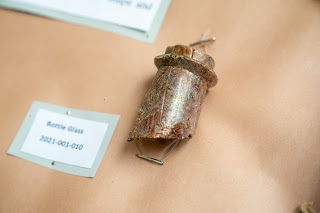Hi everyone,
During the open house, I found that a lot of people were interested in how the glass, specifically window pane fragments, found at the site were brought all the way from France to Michigan. They asked about how the glass arrived unbroken and how we knew that the glass wasn’t made on site.
 Before I go any further, I want to tell you a little bit about the two types of glass we find on the site, bottle glass and window glass, so you understand the difference. Bottle glass is much thicker and often comes in shades of blue and green. Some of the bottle glass fragments we have recovered can be over a half of a centimeter thick, and so dark that it looks like a solid color until you hold it up to a light. Generally, the glass fragments will have some sort of curved aspect to them, however this isn't always the case. In comparison to bottle glass, window glass is extremely thin! There are pieces in the Fort St. Joseph collection that are just over a 1 millimeter thick. It is generally a light green color, but sometimes it can be more clear.
Before I go any further, I want to tell you a little bit about the two types of glass we find on the site, bottle glass and window glass, so you understand the difference. Bottle glass is much thicker and often comes in shades of blue and green. Some of the bottle glass fragments we have recovered can be over a half of a centimeter thick, and so dark that it looks like a solid color until you hold it up to a light. Generally, the glass fragments will have some sort of curved aspect to them, however this isn't always the case. In comparison to bottle glass, window glass is extremely thin! There are pieces in the Fort St. Joseph collection that are just over a 1 millimeter thick. It is generally a light green color, but sometimes it can be more clear.
At the turn of the 18th century, France was undergoing an industry wide revolution in glass making techniques and abilities. For window panes, glass makers began to create “plate glass” which was made by pouring glass into a mold. This glass could be made easily and quickly, but was of a much lower quality than blown glass. Window glass from the 17th and 18th century often has bubbles and impurities included in the glass, making it easy for us to identify when the glass was made.
So how did the window glass get here without breaking? Well, It’s important to consider two things. First, windows were much smaller than they are today. Windows glass was a luxury item that not everybody would be able to afford, or even want to spend their money on. Small pieces of glass are significantly easier to transport than large modern windows, and don't require as much protection as you might expect. A blanket, a box with sand acting as packing material, or a hide could be used to protect the glass from impacts or debris. Second, most of the materials at the fort were transported almost entirely by ship and boat. At the time, this method of transportation would be significantly smoother and faster than any sort of overland transportation. The strategic location of Fort St. Joseph allowed easier transportation and access to the delicate glass.
I hope this helped shed some light on how glass was delivered to the fort. Thanks for showing up to the site and Archaeology Open House this summer, and for continuing to support the Project!
